Himalayan Balsam Is Highly Invasive And Spreading Fast: How To Halt Its Spread

Reviewed By COLIN SKELLY

Colin is a Horticulturist and Horticultural Consultant with experience in a range of practical and managerial roles across heritage, commercial and public horticulture. He holds the Royal Horticultural Society’s Master of Horticulture award and has a particular interest in horticultural ecology and naturalistic planting for habitat and climate resilience.
Himalayan Balsam is very robust and pretty, but it is just as undesirable.
Of montane origin, this tough annual rapidly grows to overhead height.
It bears a profusion of unusual and undeniably lovely bright pink flowers that are set off by light green foliage on a well-branched form.
Unfortunately, it is an aggressive alien species that is highly invasive throughout Europe.
About Himalayan Balsam
Himalayan Balsam, formally known as Impatiens glandulifera, is a very pretty and unusual flowering plant originating in the Kashmiri Himalayas north of Pakistan and India.1Himalayan balsam. (n.d.). The Wildlife Trusts. Retrieved March 17, 2023, from https://www.wildlifetrusts.org/wildlife-explorer/wildflowers/himalayan-balsam
Unfortunately, it is an aggressive species that can outcompete native ones and becomes invasive in temperate, tundra and similar climatic zones.
Though it is an annual, it is vigorous and propagates exceptionally efficiently, as its nectar draws swarms of bees which, in turn, cross-pollinate the flowers very effectively.
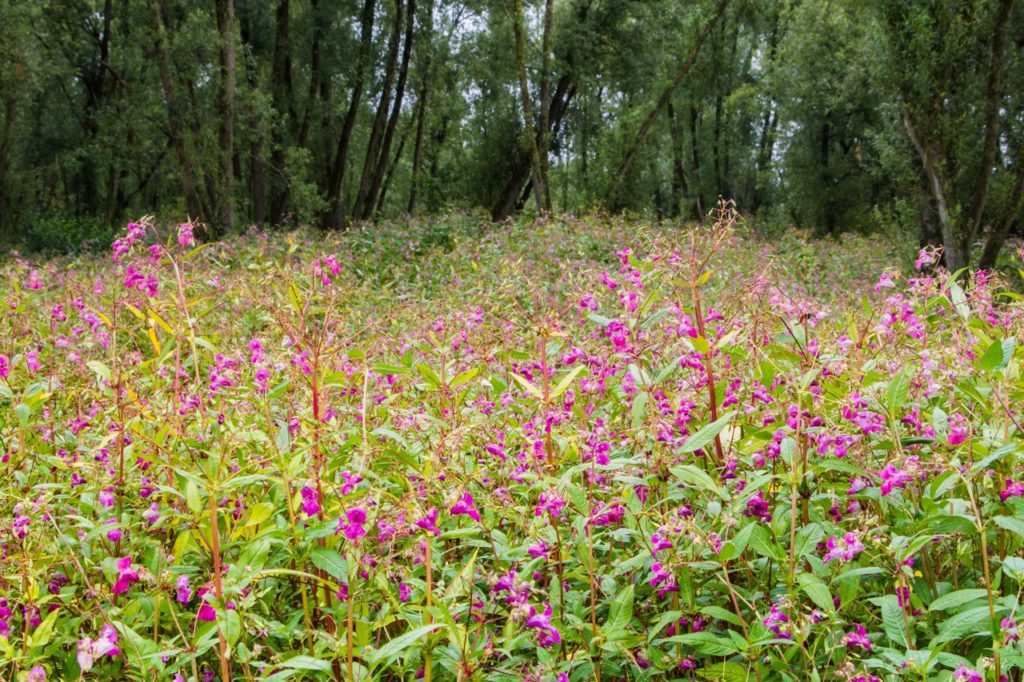
It also produces equally copious amounts of seeds, which are dispersed by seedpod explosions (ballochory).
A large number of seeds are then scattered around each mature plant, so it is little wonder that Himalayan Balsam steadily colonises good-sized swaths of the ground by forming monoculture thickets.
This species itself does not need much sunlight, but because of its own height and its survival strategy of forming dense thickets, it starves other shorter native species of much-needed sunlight, gradually eliminating them.
It is also indifferent to the soil, growing in poor as well as rich soils, and light as well as heavy soils, with about equal facility.
Identifying Himalayan Balsam
It is not for nothing that Himalayan Balsam is often called ‘Policeman’s Helmet’, as the flower’s shape really does bring to mind a bobby’s hat, except for the fact that its colour varies from pale pink through to white.
This uncommon flower is somewhat like a flared tube with two flaps.
The flowers are borne on racemes and occur in profusion in the summer and autumn on a tall, well-branched shrub that reaches up to 2-3m tall.
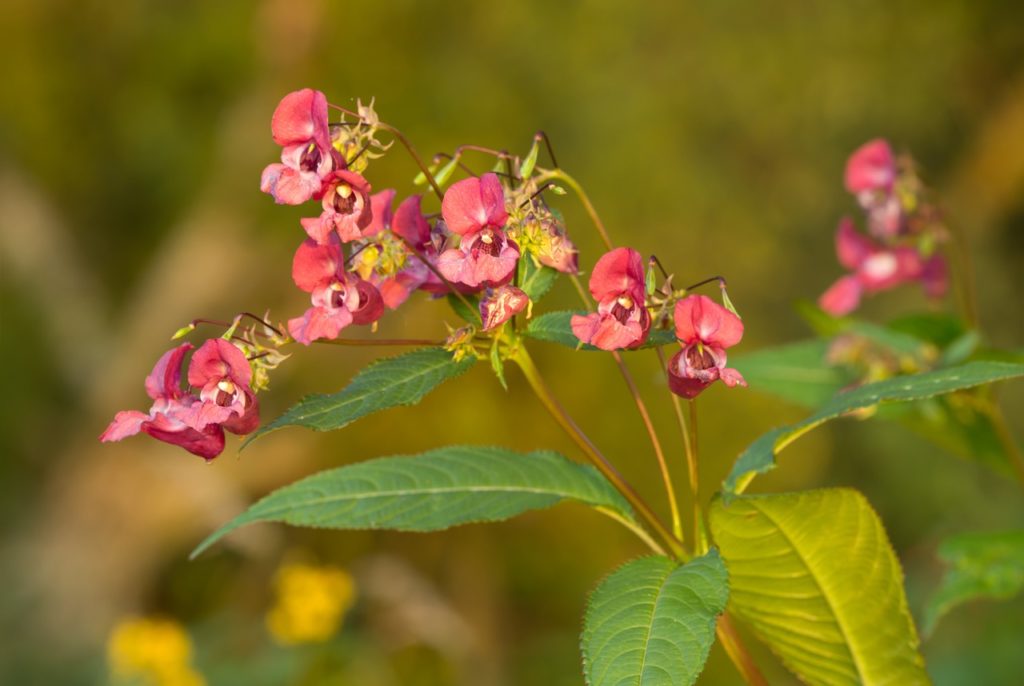
The flowers emit a strong, sickly-sweet scent.
If you see such a flowering plant and further notice that it has light, bright green leaves that are elongated and lanceolate with visible veining and are borne on stems that have a reddish tone, it is very likely Himalayan Balsam.
You would encounter Himalayan Balsam on riverbanks, alongside watercourses, near rubbish tips and in waste ground.
It also grows on forest and woodland edges, in fields and meadows and around ditches.
Is Himalayan Balsam Invasive?
Yes.
In fact, it has been flagged by the United Kingdom’s Department for Environment, Food & Rural Affairs and the Animal and Plant Health Agency since 2nd August 2017 as a non-native invasive plant species in England and Wales.2Himalayan balsam. (n.d.-b). Public Information on Invasive Species in Wales. Retrieved March 17, 2023, from https://www.gov.wales/sites/default/files/publications/2022-03/himalayan-balsam-public-information-controlling-invasive-species-wales.pdf
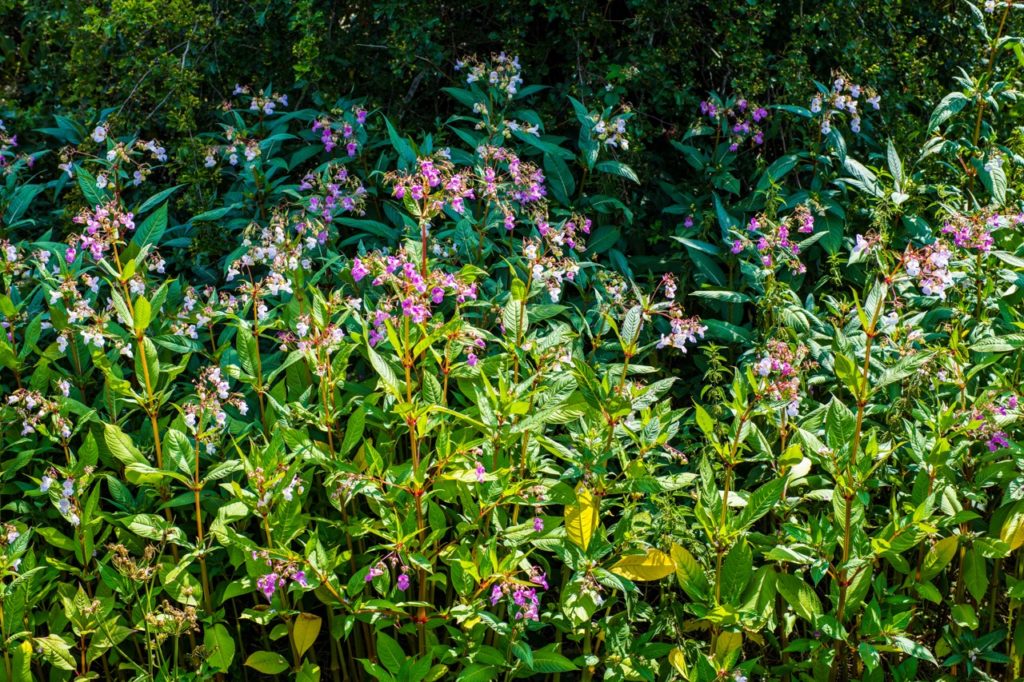
It also appears in the EU Regulation on Invasive Alien Species which remains applicable to the United Kingdom.3Invasive alien species. (n.d.). European Commission: Environment. Retrieved March 17, 2023, from https://environment.ec.europa.eu/topics/nature-and-biodiversity/invasive-alien-species_en
Efforts to halt its spread are underway in several regions of the country and it is often referred to as a weed.
“The classification of Himalayan Balsam as an invasive non-native plant species means it must not be planted in the wild and if identified on a homeowner’s land it must be stopped from spreading to neighbouring land,” shares Master Horticulturist Colin Skelly.4How to stop invasive non-native plants from spreading. (2022, February 2). GOV.UK. Retrieved June 13, 2023, from https://www.gov.uk/guidance/prevent-the-spread-of-harmful-invasive-and-non-native-plants#:~:text=Types%20of%20invasive%20non%2Dnative%20plants,-The%20most%20commonly&text=Giant%20hogweed,New%20Zealand%20pygmyweed
How Do These Plants Disperse Their Seeds?
They disperse their seeds by a rather dramatic method of seed capsule explosion called ballochory.5Seed dispersal: 5 ways trees spread seeds. (2019, August 23). Woodland Trust. Retrieved March 17, 2023, from https://www.woodlandtrust.org.uk/blog/2019/08/seed-dispersal/
The pretty flowers develop into seedpods or capsules in autumn.
Over time, as moisture from a capsule evaporates, it keeps deforming and eventually explodes noisily, scattering its seeds nearby and even up to 7m metres away.
Drying capsules can also explode if they are physically disturbed, sometimes merely touched, by wildlife.
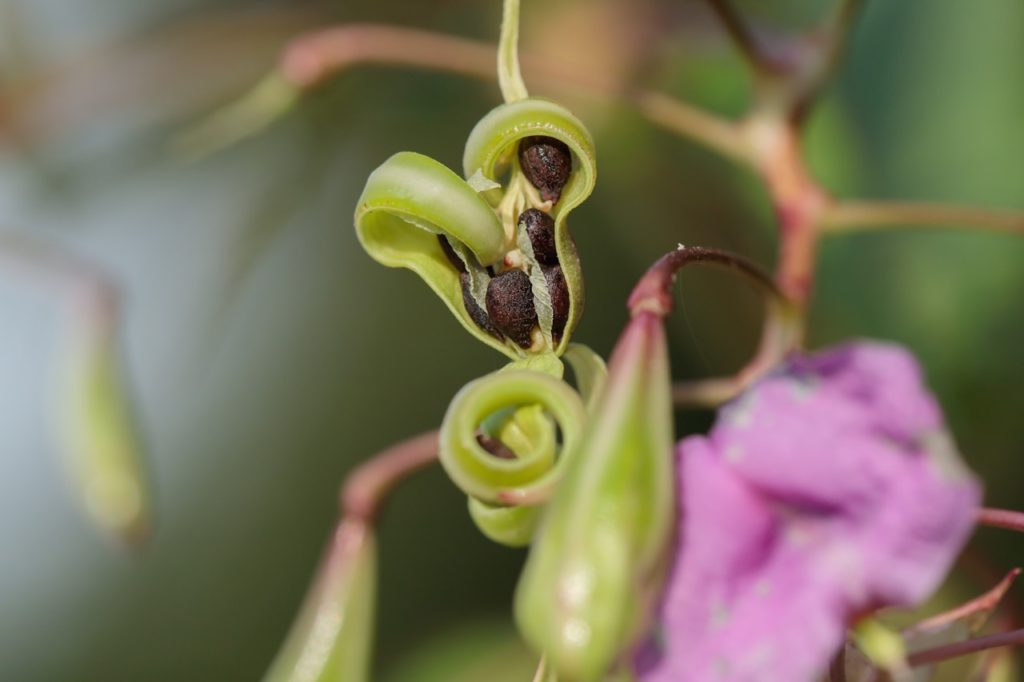
Unfortunately, these cunning colonisers also have a secondary method of seed dispersal!
As mentioned, Himalayan Balsam plants are fond of growing by riverbanks and watercourses.
When such riverine members’ seedpods explode, many seeds fall into the waterway and the flowing water then carries the seeds far and wide.
The seeds that are subsequently deposited on the ground then grow into new plants a great distance from the original.
This method of seed dispersal is known as hydrochory.6Craft, C. (2016). Hydrochory. Science Direct, 3–22. https://doi.org/10.1016/b978-0-12-407232-9.00001-4
How To Control Himalayan Balsam
From a professional and scientific standpoint, Himalayan Balsam is best controlled systemically by reducing the nutrient-richness of riparian areas and the ground around those waterways that have been invaded by this invasive plant.
Doing so affords native species a better chance to compete.
Some local plants are able to gut it out in poorer soils a little better than Himalayan Balsam, whereas the latter positively flourish in rich soils near waterways.
In the United Kingdom, various regional conservation organisations schedule balsam bashing events, usually in June.7The Big Balsam Bash 2022. (2022, April 14). Groundwork. Retrieved March 17, 2023, from https://www.groundwork.org.uk/bigbalsambash2022/
A group of volunteers walks through areas known to be colonised by the plant, uprooting, cutting and otherwise destroying its stands.
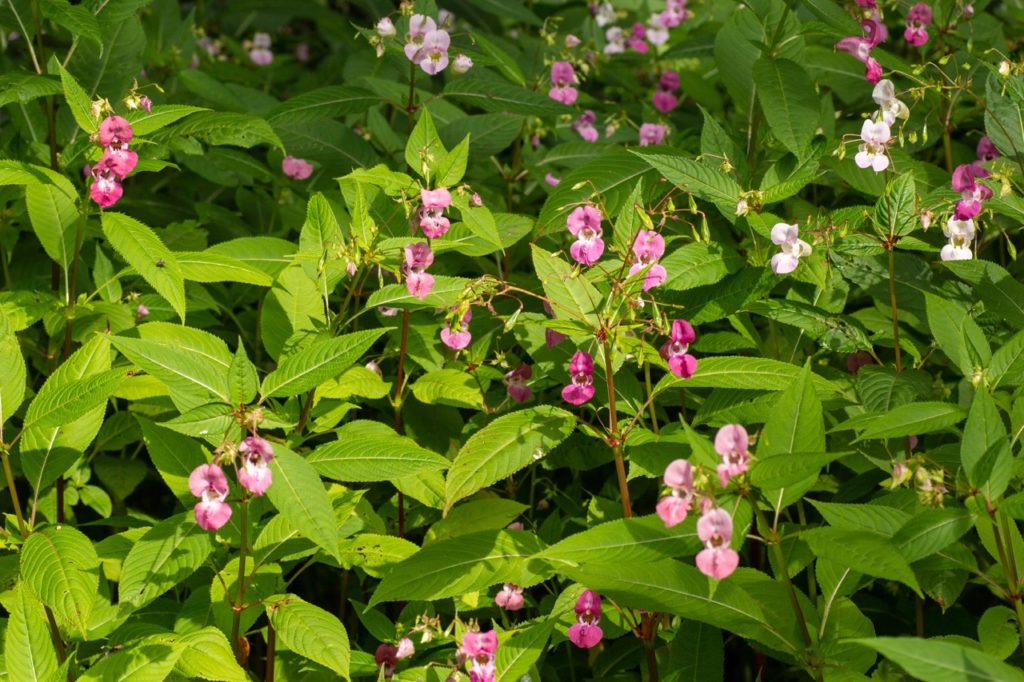
Out in the open, strimming is also used and it too is an effective method of control.
It is possibly the most efficient method to deal with dense thickets before the plants have started to set seed.
Plants should be cut off at the base of the stem.
As an individual gardener, your best bets are to uproot the plants and use particular kinds of weedkillers.
Both the RHS and the Centre for Ecology & Hydrology recommend uprooting and cutting as the primary methods of effective control.8Himalayan Balsam. (n.d.). Peak District: Gov. Retrieved March 17, 2023, from https://www.peakdistrict.gov.uk/__data/assets/pdf_file/0019/48016/himalayan_balsam_control.pdf
The downside to cutting any part of the plant is that if this is done above the first node on the stem, especially before June, nothing will be achieved, as the plant’s strong roots will ensure its survival.
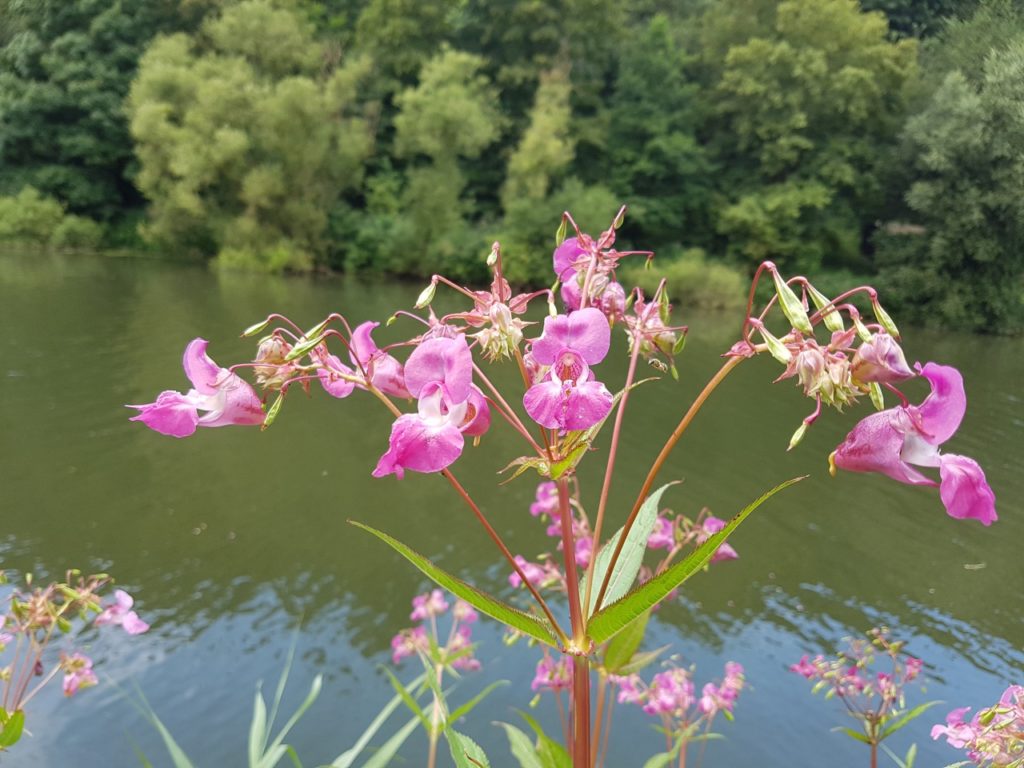
All that will happen is that the plant will become bushy.
Pulling up these plants, preferably as early as possible in the season, is a better method of control than cutting it.
If you pull them up after they have started forming seed capsules, watch out for inadvertent seed dispersal!
Lay the uprooted plants on plastic sheets.
I. glandulifera can also be controlled by chemical means.
Use contact weedkillers on them before they form seed capsules, remembering that the earlier this is done, the better.
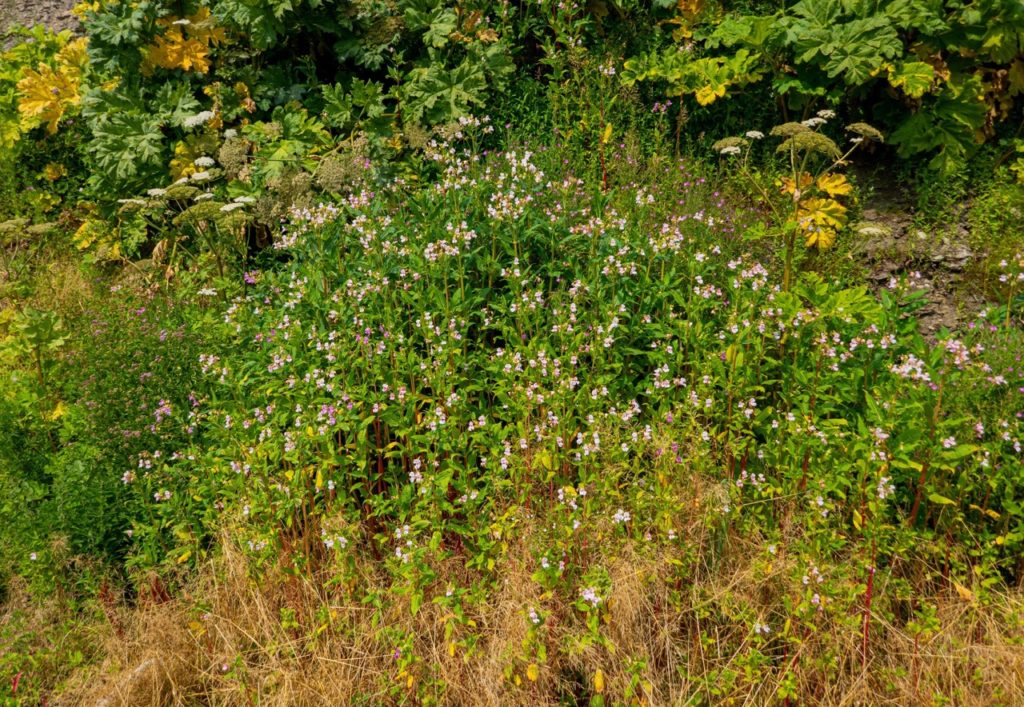
Recent botanical research has uncovered a very effective and targeted biological control for Himalayan Balsam, a rust fungus named Puccinia komarovii var. glanduliferae.9Tanner, R., Ellison, C., Kassai-Jáger, G., Varia, S., Djeddour, S., Singh, M., Csiszár, Á., Csontos, P., Kiss, L., & Evans, H. C. (2015). Puccinia komarovii var. glanduliferae var. nov.: a fungal agent for the biological control of Himalayan balsam (Impatiens glandulifera). European Journal of Plant Pathology, 141(2), 247–266. https://doi.org/10.1007/s10658-014-0539-x
This is a Himalayan rust fungus that infects and kills Himalayan Balsam with near-total specificity.
It has been discovered and even tested and was subsequently found to attack a few other Balsam impatiens, though it does not affect Western ornamental impatiens, the popular bedding plants.
Research is ongoing to identify and isolate a strain of this rust fungus that will be specific exclusively to I. glandulifera.
Plant Disposal
Burning I. glandulifera is an effective method of halting its spread and destroying it, but burning plants and plant material is subject to somewhat differing regulations in England and Wales, Scotland, and Northern Ireland.
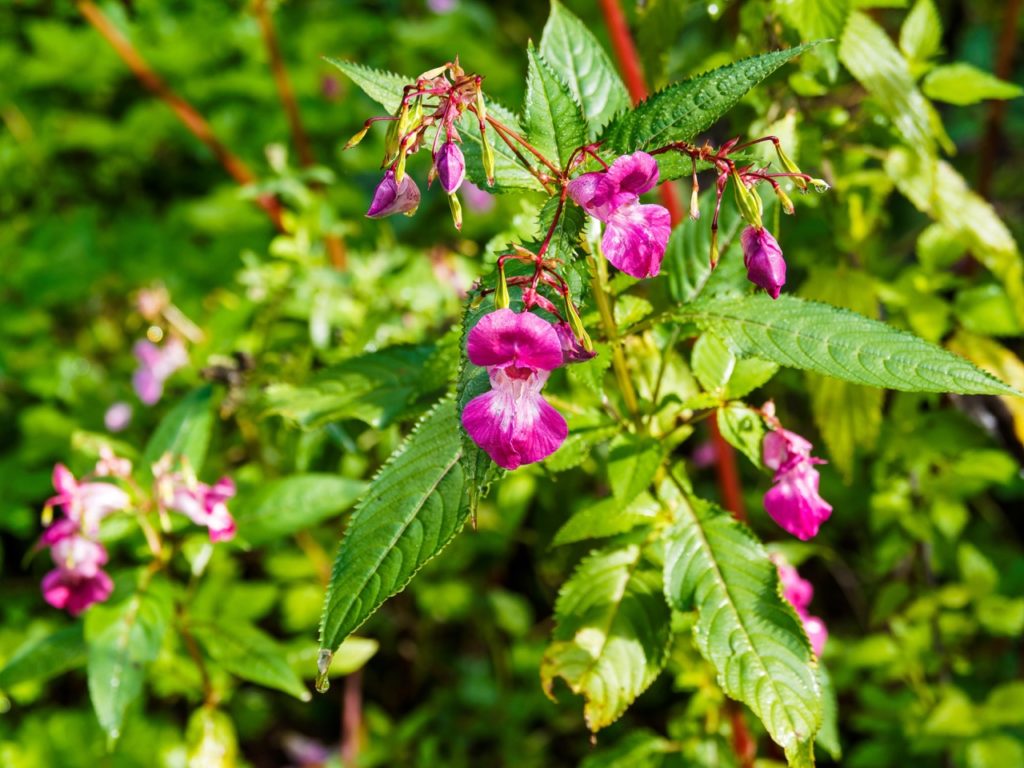
Generally, you are required to notify appropriate local authorities in advance of burning plant material, ensure that the burning does not cause pollution or nuisance and that only white smoke, not black, is produced.
I’d suggest that before burning any plant material, you acquaint yourself with the local rules and regulations by paying a visit to the website of your district council or environmental office.
Composting Himalayan Balsam
You might be able to compost your Himalayan Balsam depending on the stage of the plant’s lifecycle.
As it is an annual, there is nothing to fear from its roots and you can just let them dry out in the sun.
The concern is that its seedpods and seeds may get into the compost heap.
The tough seeds may well germinate in the compost or wait until the compost is used, as seeds are viable for around 18-24 months.
Either way, a compost of this kind would facilitate the spread of this invasive plant.
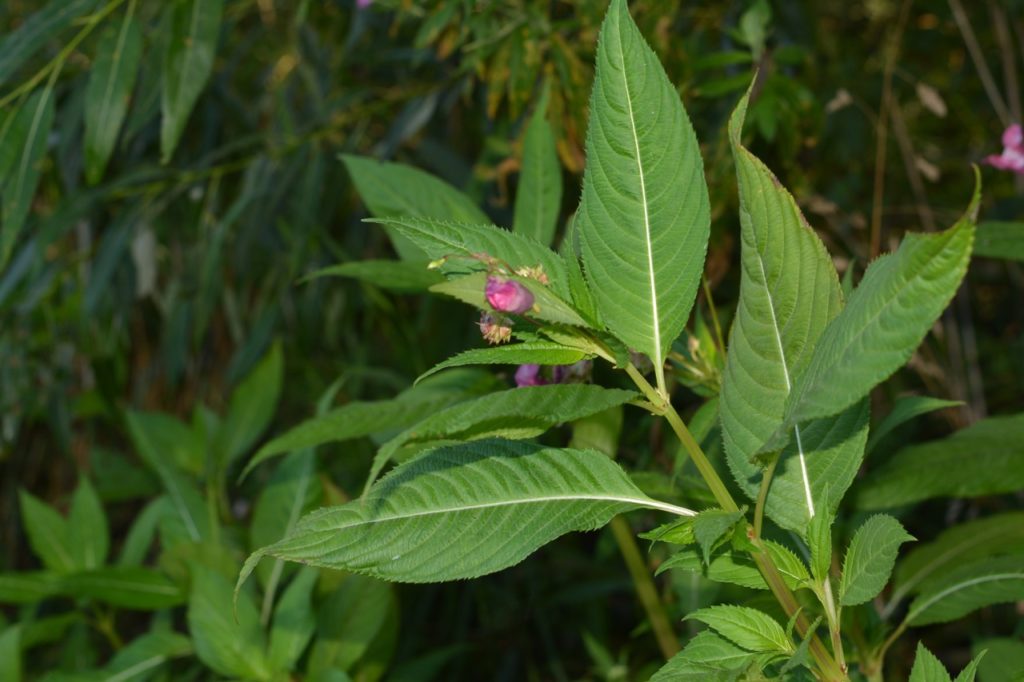
Keeping these facts in mind, you may compost Himalayan Balsam at any stage of its lifecycle up until the time that buds have started to flower.
If any flowers of a plant have withered, do not compost them.
You never know if you will be adding seedpods and seeds to your compost.
You can search for seedpods and remove them or compost only the foliage, but that would hardly be worth the time and effort.
Considering how aggressive and invasive the plant is and the problems that are being faced in trying to limit its spread, I’d suggest that you play it safe and avoid composting Himalayan Balsam.
Also, be aware that many localities prohibit the dumping of this and other similar plants into rubbish skips.
References
- 1Himalayan balsam. (n.d.). The Wildlife Trusts. Retrieved March 17, 2023, from https://www.wildlifetrusts.org/wildlife-explorer/wildflowers/himalayan-balsam
- 2Himalayan balsam. (n.d.-b). Public Information on Invasive Species in Wales. Retrieved March 17, 2023, from https://www.gov.wales/sites/default/files/publications/2022-03/himalayan-balsam-public-information-controlling-invasive-species-wales.pdf
- 3Invasive alien species. (n.d.). European Commission: Environment. Retrieved March 17, 2023, from https://environment.ec.europa.eu/topics/nature-and-biodiversity/invasive-alien-species_en
- 4How to stop invasive non-native plants from spreading. (2022, February 2). GOV.UK. Retrieved June 13, 2023, from https://www.gov.uk/guidance/prevent-the-spread-of-harmful-invasive-and-non-native-plants#:~:text=Types%20of%20invasive%20non%2Dnative%20plants,-The%20most%20commonly&text=Giant%20hogweed,New%20Zealand%20pygmyweed
- 5Seed dispersal: 5 ways trees spread seeds. (2019, August 23). Woodland Trust. Retrieved March 17, 2023, from https://www.woodlandtrust.org.uk/blog/2019/08/seed-dispersal/
- 6Craft, C. (2016). Hydrochory. Science Direct, 3–22. https://doi.org/10.1016/b978-0-12-407232-9.00001-4
- 7The Big Balsam Bash 2022. (2022, April 14). Groundwork. Retrieved March 17, 2023, from https://www.groundwork.org.uk/bigbalsambash2022/
- 8Himalayan Balsam. (n.d.). Peak District: Gov. Retrieved March 17, 2023, from https://www.peakdistrict.gov.uk/__data/assets/pdf_file/0019/48016/himalayan_balsam_control.pdf
- 9Tanner, R., Ellison, C., Kassai-Jáger, G., Varia, S., Djeddour, S., Singh, M., Csiszár, Á., Csontos, P., Kiss, L., & Evans, H. C. (2015). Puccinia komarovii var. glanduliferae var. nov.: a fungal agent for the biological control of Himalayan balsam (Impatiens glandulifera). European Journal of Plant Pathology, 141(2), 247–266. https://doi.org/10.1007/s10658-014-0539-x

